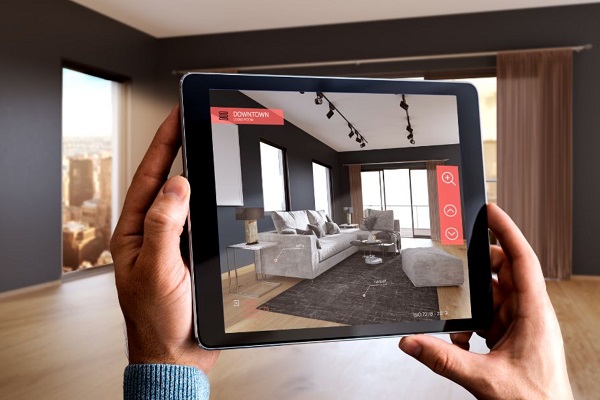In our increasingly digital world, industries across the board are leveraging technology to elevate customer experience and improve business processes.

One such advancement, Augmented Reality (AR), is steadily gaining traction in a rather unexpected sector: the flooring industry. From epoxy to hardwood, AR is revolutionizing the way we envision and install our floors.
The Evolution of Selection and Installation Solutions
Over the years, the flooring industry has continually sought ways to make this process easier, from comprehensive showrooms to detailed digital catalogs. Now, we stand on the brink of a technological breakthrough that promises to revolutionize the industry: Augmented Reality (AR).
Traditional Showrooms: A Sensory Experience
In the past, visiting a physical showroom was the most reliable way to explore flooring options. Showrooms allowed customers to see a wide variety of floor types, styles, and finishes in person.
They could touch the materials, see the colors under different light conditions, and even walk on certain samples to get a feel for the underfoot comfort and noise level.
Home Visits: Bringing the Showroom to You
In an effort to provide a more convenient service, some flooring companies began offering home visits. In this scenario, a representative would bring a selection of samples to a customer’s home.
This personalized service not only saved the customer a trip to the showroom but also allowed them to see how different flooring options looked in their own space.
Digital Catalogs: Anytime, Anywhere
With the advent of the internet, digital catalogs became a popular tool for browsing flooring options. Companies could showcase their entire range of products online, complete with high-quality images and detailed descriptions.
Customers could browse these catalogs anytime, anywhere, and even order samples to be delivered to their homes.
Mobile Apps: Personalized and Interactive
In recent years, mobile apps have taken digital catalogs a step further by providing a more interactive and personalized shopping experience.
These apps allow users to filter options based on their preferences, save their favorites, and even visualize some products in their space using simple image manipulation.
While each of these solutions has its strengths, they also come with limitations. Physical showrooms and home visits can be time-consuming and might not fully represent all available options.
Digital catalogs and mobile apps, while convenient, lack the tactile experience of traditional showrooms and the spatial accuracy of home visits.
This brings us to the advent of Augmented Reality (AR), a technology that promises to combine the best aspects of traditional and digital solutions. With AR, customers can visualize a wide variety of flooring options in their own space in real-time, using just a smartphone or AR-enabled device.
This offers a whole new level of interactivity and personalization, set to transform the flooring industry.
What is Augmented Reality?
Before we dive into the specifics, let’s briefly discuss what AR is. Augmented Reality is a technology that overlays computer-generated images onto real-world settings.
In contrast to Virtual Reality, which immerses you entirely into a simulated environment, AR enhances your existing environment by adding virtual elements to it. The result is a blended reality where digital and physical worlds coexist.
A Closer Look: AR for Different Flooring Types
In the flooring industry, AR allows consumers to virtually ‘try before they buy.’ With a smartphone or AR-enabled device, customers can overlay different flooring options onto a live view of their own space.
Want to see how your living room would look with oak hardwood? Or how about a vibrant epoxy floor in your garage? With AR, these questions can be answered in a few taps, saving time, money, and potential dissatisfaction.
Epoxy Flooring
Epoxy flooring, known for its durability and striking appearance, is a popular choice for both residential and commercial spaces. However, the multitude of colors and patterns available can make decision-making a challenge.
Here’s where AR comes in. By simulating how different epoxy finishes would look in a specific space, customers can make informed decisions, visualizing the aesthetic and functional impacts before committing.
Hardwood and Laminate Flooring
For those considering hardwood or laminate flooring, the possibilities can seem endless. From the type of wood and grain pattern to the finish and plank size, each decision impacts the overall look and feel of a space.
AR technology can streamline this process, enabling customers to virtually sample a range of flooring options in their own homes, effectively bringing the showroom experience to them.
Carpeting and Area Rugs
AR can be equally beneficial when selecting carpets or area rugs. Beyond just color and pattern, AR can help customers understand how different pile heights and rug sizes would look and fit in their spaces.
Tile Flooring
Tile flooring, with its numerous materials, sizes, and installation patterns, can significantly benefit from AR visualization.
By showing customers how different tile designs and layouts would look in their bathrooms, kitchens, or outdoor spaces, AR can help demystify the selection process and encourage more creative and personalized design choices.
The Bigger Picture: AR in the Flooring Industry
While the immediate benefit of AR in the flooring industry is evident in enhancing the customer experience, the implications go far beyond. This technology can streamline business operations, reducing the need for physical samples and showrooms, and making the sales process more efficient.
AR can facilitate communication between customers, designers, and installers, ensuring that everyone shares the same vision for the project. This can reduce errors and miscommunications, leading to more successful installations and satisfied customers.
Augmented Reality is setting a new standard in the flooring industry. By blending digital imagery with real-world environments, it’s enhancing the way we select and install flooring, from epoxy to hardwood and everything in between.
As AR technology continues to evolve, it promises to further revolutionize the industry, opening up exciting possibilities for both businesses and consumers alike. As we step into the future of flooring, it’s clear that technology will be right there under our feet.